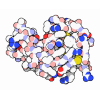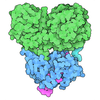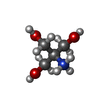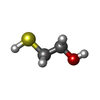+ Open data
Open data
- Basic information
Basic information
| Entry | Database: PDB / ID: 7l37 | ||||||
|---|---|---|---|---|---|---|---|
| Title | T4 Lysozyme L99A - Apo - RT | ||||||
 Components Components | Endolysin | ||||||
 Keywords Keywords | HYDROLASE / RTX / apo / L99A | ||||||
| Function / homology |  Function and homology information Function and homology informationviral release from host cell by cytolysis / peptidoglycan catabolic process / cell wall macromolecule catabolic process / lysozyme / lysozyme activity / host cell cytoplasm / defense response to bacterium Similarity search - Function | ||||||
| Biological species |  Enterobacteria phage T4 (virus) Enterobacteria phage T4 (virus) | ||||||
| Method |  X-RAY DIFFRACTION / X-RAY DIFFRACTION /  SYNCHROTRON / SYNCHROTRON /  MOLECULAR REPLACEMENT / Resolution: 1.439 Å MOLECULAR REPLACEMENT / Resolution: 1.439 Å | ||||||
 Authors Authors | Fischer, M. / Bradford, S.Y.C. | ||||||
 Citation Citation |  Journal: Chem Sci / Year: 2021 Journal: Chem Sci / Year: 2021Title: Temperature artifacts in protein structures bias ligand-binding predictions. Authors: Bradford, S.Y.C. / El Khoury, L. / Ge, Y. / Osato, M. / Mobley, D.L. / Fischer, M. | ||||||
| History |
|
- Structure visualization
Structure visualization
| Structure viewer | Molecule:  Molmil Molmil Jmol/JSmol Jmol/JSmol |
|---|
- Downloads & links
Downloads & links
- Download
Download
| PDBx/mmCIF format |  7l37.cif.gz 7l37.cif.gz | 88.8 KB | Display |  PDBx/mmCIF format PDBx/mmCIF format |
|---|---|---|---|---|
| PDB format |  pdb7l37.ent.gz pdb7l37.ent.gz | 66.3 KB | Display |  PDB format PDB format |
| PDBx/mmJSON format |  7l37.json.gz 7l37.json.gz | Tree view |  PDBx/mmJSON format PDBx/mmJSON format | |
| Others |  Other downloads Other downloads |
-Validation report
| Summary document |  7l37_validation.pdf.gz 7l37_validation.pdf.gz | 432.4 KB | Display |  wwPDB validaton report wwPDB validaton report |
|---|---|---|---|---|
| Full document |  7l37_full_validation.pdf.gz 7l37_full_validation.pdf.gz | 432.4 KB | Display | |
| Data in XML |  7l37_validation.xml.gz 7l37_validation.xml.gz | 8.9 KB | Display | |
| Data in CIF |  7l37_validation.cif.gz 7l37_validation.cif.gz | 11.7 KB | Display | |
| Arichive directory |  https://data.pdbj.org/pub/pdb/validation_reports/l3/7l37 https://data.pdbj.org/pub/pdb/validation_reports/l3/7l37 ftp://data.pdbj.org/pub/pdb/validation_reports/l3/7l37 ftp://data.pdbj.org/pub/pdb/validation_reports/l3/7l37 | HTTPS FTP |
-Related structure data
| Related structure data | 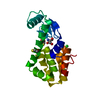 7l38C  7l39C  7l3aC  7l3bC  7l3cC  7l3dC  7l3eC  7l3fC  7l3gC  7l3hC  7l3iC  7l3jC  7l3kC  4w51S S: Starting model for refinement C: citing same article ( |
|---|---|
| Similar structure data |
- Links
Links
- Assembly
Assembly
| Deposited unit | 
| ||||||||
|---|---|---|---|---|---|---|---|---|---|
| 1 |
| ||||||||
| Unit cell |
| ||||||||
| Components on special symmetry positions |
|
- Components
Components
| #1: Protein | Mass: 18620.387 Da / Num. of mol.: 1 / Mutation: R12G/I137R/L99A Source method: isolated from a genetically manipulated source Source: (gene. exp.)  Enterobacteria phage T4 (virus) / Production host: Enterobacteria phage T4 (virus) / Production host:  | ||||
|---|---|---|---|---|---|
| #2: Chemical | ChemComp-TRS / | ||||
| #3: Chemical | ChemComp-CL / | ||||
| #4: Chemical | | #5: Water | ChemComp-HOH / | Has ligand of interest | N | |
-Experimental details
-Experiment
| Experiment | Method:  X-RAY DIFFRACTION / Number of used crystals: 1 X-RAY DIFFRACTION / Number of used crystals: 1 |
|---|
- Sample preparation
Sample preparation
| Crystal | Density Matthews: 2.84 Å3/Da / Density % sol: 56.73 % / Description: Diamond-shaped |
|---|---|
| Crystal grow | Temperature: 291 K / Method: vapor diffusion, hanging drop Details: Crystals were grown from a 10 mg/mL frozen protein solution by the hanging drop method at 291-293K, with a 1:1 drop ratio of protein to solution and over a well solution of 0.1 M Tris- ...Details: Crystals were grown from a 10 mg/mL frozen protein solution by the hanging drop method at 291-293K, with a 1:1 drop ratio of protein to solution and over a well solution of 0.1 M Tris-hydrochloride (pH 8), 20%-26% (w/v) PEG 4000, 70-170 mM lithium citrate, 8%-18% 2-propanol, 50 mM 2-mercaptoethanol, and 50 mM 2-hydroxyethyl disulfide Temp details: 291-293K |
-Data collection
| Diffraction | Mean temperature: 278 K / Ambient temp details: RT / Serial crystal experiment: N |
|---|---|
| Diffraction source | Source:  SYNCHROTRON / Site: SYNCHROTRON / Site:  APS APS  / Beamline: 22-ID / Wavelength: 1 Å / Beamline: 22-ID / Wavelength: 1 Å |
| Detector | Type: DECTRIS EIGER X 16M / Detector: PIXEL / Date: Mar 18, 2018 |
| Radiation | Protocol: SINGLE WAVELENGTH / Monochromatic (M) / Laue (L): M / Scattering type: x-ray |
| Radiation wavelength | Wavelength: 1 Å / Relative weight: 1 |
| Reflection | Resolution: 1.439→49.26 Å / Num. obs: 39149 / % possible obs: 99.9 % / Redundancy: 9.9 % / CC1/2: 0.999 / Rmerge(I) obs: 0.061 / Net I/σ(I): 15.5 |
| Reflection shell | Resolution: 1.439→1.46 Å / Redundancy: 9 % / Rmerge(I) obs: 0.852 / Num. unique obs: 1868 / CC1/2: 0.545 / % possible all: 96.8 |
- Processing
Processing
| Software |
| ||||||||||||||||||||||||||||||||||||||||||||||||||||||||||||||||||||||||||||||||||||||||||
|---|---|---|---|---|---|---|---|---|---|---|---|---|---|---|---|---|---|---|---|---|---|---|---|---|---|---|---|---|---|---|---|---|---|---|---|---|---|---|---|---|---|---|---|---|---|---|---|---|---|---|---|---|---|---|---|---|---|---|---|---|---|---|---|---|---|---|---|---|---|---|---|---|---|---|---|---|---|---|---|---|---|---|---|---|---|---|---|---|---|---|---|
| Refinement | Method to determine structure:  MOLECULAR REPLACEMENT MOLECULAR REPLACEMENTStarting model: 4W51 Resolution: 1.439→36.031 Å / SU ML: 0.16 / Cross valid method: THROUGHOUT / σ(F): 1.33 / Phase error: 20.4 / Stereochemistry target values: ML
| ||||||||||||||||||||||||||||||||||||||||||||||||||||||||||||||||||||||||||||||||||||||||||
| Solvent computation | Shrinkage radii: 0.9 Å / VDW probe radii: 1.11 Å / Solvent model: FLAT BULK SOLVENT MODEL | ||||||||||||||||||||||||||||||||||||||||||||||||||||||||||||||||||||||||||||||||||||||||||
| Displacement parameters | Biso max: 74.43 Å2 / Biso mean: 25.8688 Å2 / Biso min: 14.25 Å2 | ||||||||||||||||||||||||||||||||||||||||||||||||||||||||||||||||||||||||||||||||||||||||||
| Refinement step | Cycle: final / Resolution: 1.439→36.031 Å
| ||||||||||||||||||||||||||||||||||||||||||||||||||||||||||||||||||||||||||||||||||||||||||
| Refine LS restraints |
| ||||||||||||||||||||||||||||||||||||||||||||||||||||||||||||||||||||||||||||||||||||||||||
| LS refinement shell | Refine-ID: X-RAY DIFFRACTION / Rfactor Rfree error: 0
|
 Movie
Movie Controller
Controller




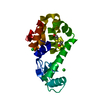


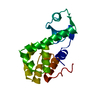
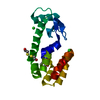
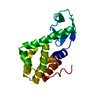
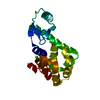

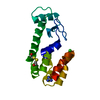
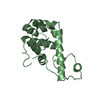
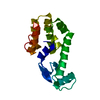

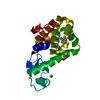
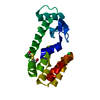
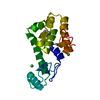
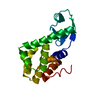

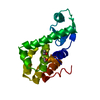
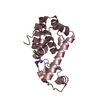
 PDBj
PDBj